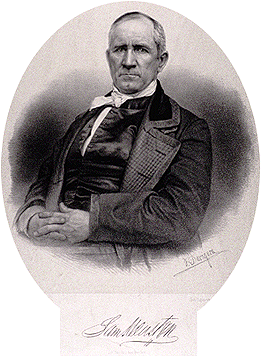|
|
|
Revival of Expansionism in the 1840s
Introduction - Revival of Expansionism - The Oregon Question - War With Mexico
By 1820, the United States already extended well beyond its original boundaries. Through the Louisiana Purchase of 1803 and treaties with Spain and Britain, the nation's borders moved west to the Rocky Mountains, north to the 49th parallel, and south to Florida and the Gulf of Mexico. These boundaries remained essentially intact until the 1840s, when the United States acquired massive territories in the Southwest and on the Pacific Coast.
A complex mix of political, social, and economic factors fueled American expansionist sentiment in the 1840s. Many Americans subscribed to the concept of "Manifest Destiny," the belief that Providence preordained the United States to occupy as much land on the continent as possible. Some saw lucrative economic opportunities in the vast stretches of arable land and superb Pacific Coast ports. Others dreamed of the romance of settling uncharted terrain, or thought the United States should expand rapidly across the continent before foreign nations could do so. These expansionist yearnings fueled American settlement in Texas and Oregon, the acquisition of which became a principal object of American foreign policy by 1845.
Texas Independence
|
With the Adams-Onis Treaty of 1819, Spain settled a long dispute with the United States over its southern border. In return for Florida and the Gulf Coast lands east of the Mississippi River, the United States foreswore all claims to Texas in the west. However, soon after the treaty was in place the Mexican War of Independence ended Spanish rule on the continent and forced Spain to relinquish all rights to Texas.
The newly independent Mexican Republic rejected all American offers to buy Texas during the 1820s and 1830s, but agreed to grant huge tracts of inexpensive land to American settlers on the condition that they convert to Catholicism, learn to speak the Spanish language, and take Mexican citizenship. In response, more than three hundred slaveholding American families settled in Texas during the 1820s. Early settlers adapted well to their new home and met the conditions for settlement set by the Mexican government. But later, tensions arose between the Mexican government and the region's Anglo and Mexican settlers over the issues of slavery, taxation, and settlement requirements. The Mexican government responded by barring any further settlement in Texas by Americans and banning slavery.
|

Samuel Houston by Francis D'Avignon (c. 1814%#151;61), Lithograph on paper, 1848, NPG.93.270, National Portrait Gallery |
The strained relationship between the Texans and the Mexican government turned violent in 1835 with the Texan Revolt. After a series of bloody engagements, including the legendary siege of the Alamo, the Texans, led by Sam Houston, won a decisive victory at San Jacinto in 1836. Following that battle, the Mexican army commander General Antonio López de Santa Anna signed, but later renounced, treaties that granted Texas independence and established its southwest boundary at the Río Grande.
While a majority of Texans and many Americans favored annexation in 1836, the admission of a slave-holding Texas (or several states formed from Texas territory) threatened the delicate balance of slave and free state representation in the Senate that had been carefully maintained since 1820. Rather than upset this balance, the United States recognized Texas as a sovereign nation, leaving the tensions between Mexico and Texas to simmer for the nine and one-half years of Texan independence.
|


